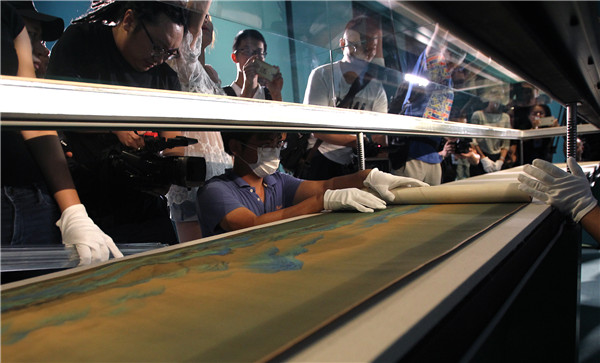
Staff members from the Palace Museum arrange the Song Dynasty masterpiece for the exhibition. (Photo by Zhang Wei/China Daily)
For the opening ceremony of the Beijing Olympic Games in 2008, a huge digital version of this painting was projected onto the center of the stadium.
The painter, Wang Ximeng, who was born in 1096, was part of the imperial painting academy of the Song Dynasty. He was tutored by Emperor Huizong, a fine art guru, and handed in this painting at the age of 18.
As for his other achievements, the details are vague. But it is known that he died in his 20s.
The painting was acquired by the Forbidden City during the reign of Qianlong (1735-96).
Meanwhile, for the two displays of the painting in 2009 and 2013, the work was not fully exhibited due to space constraints.
A special exhibition case has been made this time to display it in full, along with the critics' postscript comments.
Referring to the critics' comments, Wang says: "A monk from the Yuan Dynasty (1271-1368) said that he had seen the painting hundreds of times, but found something new each time he viewed it."
According to Wang, blue-green paintings were a very important genre in Chinese landscape painting in the Tang (618-907) and Song dynasties. But this status was lost to ink-and-wash works after literati paintings, which emphasize more subtle and plain emotions, rose in prominence in the Yuan Dynasty.
"The change led people to nurture a stereotype that Chinese paintings are ink and wash," says Wang. "But traditional Chinese paintings were abundant in color as well."
The upcoming exhibition is a bid to promote blue-green paintings and revive the lost position of this genre, says Wang. "This will help people understand Chinese landscape paintings," he says.
The exhibition has five sections, including the origin of blue and green painting in the fourth century, its peak in the Song Dynasty, later developments and finally its absorption of Western techniques.


















































